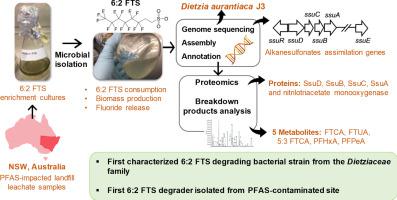Science of the Total Environment ( IF 8.2 ) Pub Date : 2022-03-16 , DOI: 10.1016/j.scitotenv.2022.154587 Valentina Méndez 1 , Sophie Holland 1 , Shefali Bhardwaj 1 , James McDonald 1 , Stuart Khan 1 , Denis O'Carroll 1 , Russell Pickford 2 , Sarah Richards 3 , Casey O'Farrell 3 , Nicholas Coleman 4 , Matthew Lee 1 , Michael J Manefield 1

|
The polyfluorinated alkyl substance 6:2 fluorotelomer sulfonate (6:2 FTS) has been detected in diverse environments impacted by aqueous film-forming foams used for firefighting. In this study, a bacterial strain (J3) using 6:2 FTS as a sulfur source was isolated from landfill leachate previously exposed to polyfluoroalkyl substances in New South Wales, Australia. Strain J3 shares 99.9% similarity with the 16S rRNA gene of Dietzia aurantiaca CCUG 35676T. Genome sequencing yielded a draft genome sequence of 37 contigs with a G + C content of 69.7%. A gene cluster related to organic sulfur utilisation and assimilation was identified, that included an alkanesulfonate monooxygenase component B (ssuD), an alkanesulfonate permease protein (ssuC), an ABC transporter (ssuB), and an alkanesulfonate-binding protein (ssuA). Proteomic analyses comparing strain J3 cultures using sulfate and 6:2 FTS as sulfur source indicated that the ssu gene cluster was involved in 6:2 FTS biodegradation. Upregulated proteins included the SsuD monooxygenase, the SsuB transporter, the ABC transporter permease (SsuC), an alkanesulfonate-binding protein (SsuA), and a nitrilotriacetate monooxygenase component B. 6:2 Fluorotelomer carboxylic acid (6:2 FTCA) and 6:2 fluorotelomer unsaturated acid (6:2 FTUA) were detected as early degradation products in cultures (after 72 h) while 5:3 fluorotelomer acid (5:3 FTCA), perfluorohexanoic acid (PFHxA) and perfluoropentanoic acid (PFPeA) were detected as later degradation products (after 168 h). This work provides biochemical and metabolic insights into 6:2 FTS biodegradation by the Actinobacterium D. aurantiaca J3, informing the fate of PFAS in the environment.
中文翻译:

Dietzia aurantiaca J3在限硫条件下对6:2氟调聚物磺酸盐的有氧生物转化
已在受用于消防的水性成膜泡沫影响的各种环境中检测到多氟烷基物质 6:2 氟调聚物磺酸盐 (6:2 FTS)。在这项研究中,使用 6:2 FTS 作为硫源的细菌菌株 (J3) 从之前在澳大利亚新南威尔士州暴露于多氟烷基物质的垃圾渗滤液中分离出来。菌株 J3 与Dietzia aurantiaca CCUG 35676 T的 16S rRNA 基因具有 99.9% 的相似性。基因组测序产生了 37 个重叠群的基因组序列草图,其中 G + C 含量为 69.7%。鉴定了与有机硫利用和同化相关的基因簇,其中包括烷磺酸单加氧酶组分 B ( ssuD )、烷磺酸渗透酶蛋白 ( ssuC ))、ABC 转运蛋白 ( ssuB ) 和烷磺酸结合蛋白 ( ssuA )。比较使用硫酸盐和 6:2 FTS 作为硫源的菌株 J3 培养物的蛋白质组学分析表明,ssu基因簇参与了 6:2 FTS 的生物降解。上调的蛋白质包括 SsuD 单加氧酶、SsuB 转运蛋白、ABC 转运蛋白通透酶 (SsuC)、烷磺酸结合蛋白 (SsuA) 和次氮基三乙酸酯单加氧酶组分 B。6:2 氟调聚物羧酸 (6:2 FTCA) 和 6: 2 种含氟调聚物不饱和酸 (6:2 FTUA) 被检测为培养物中的早期降解产物(72 小时后),而 5:3 含氟调聚物酸 (5:3 FTCA)、全氟己酸 (PFHxA) 和全氟戊酸 (PFPeA) 被检测为后来的降解产物(168 小时后)。这项工作为奥兰蒂亚放线菌 J3的 6:2 FTS 生物降解提供了生化和代谢方面的见解,从而为环境中 PFAS 的命运提供了信息。





















































 京公网安备 11010802027423号
京公网安备 11010802027423号